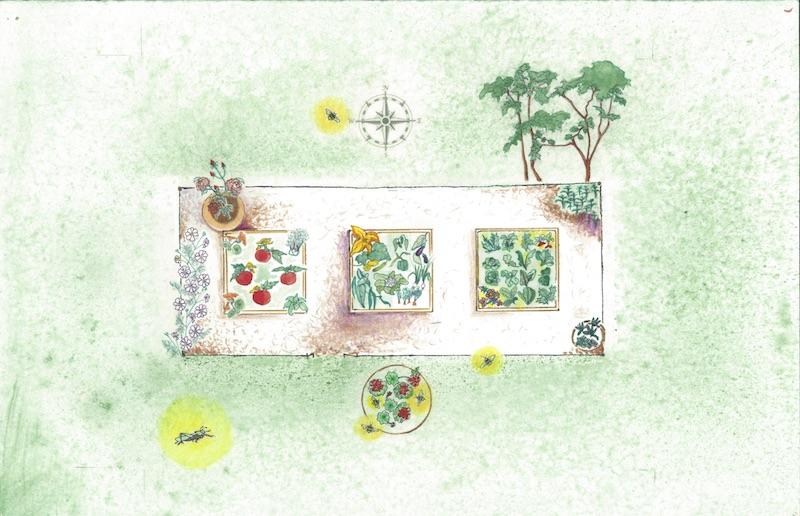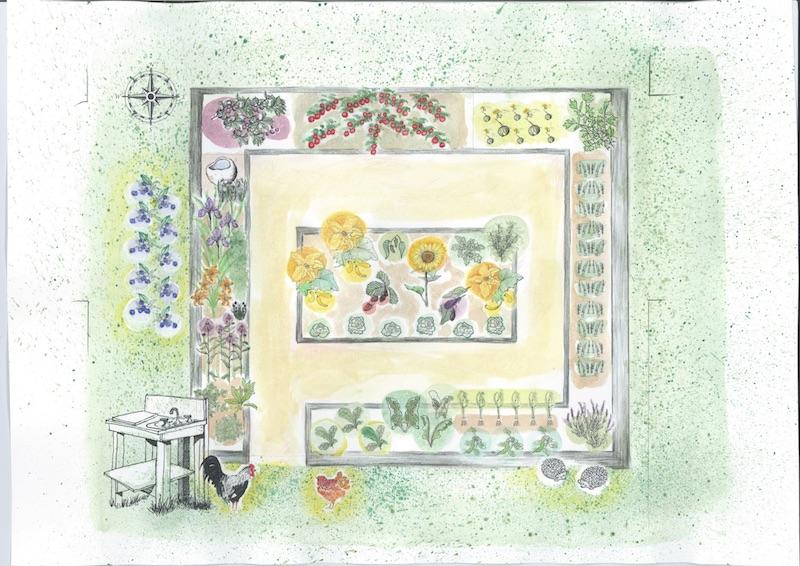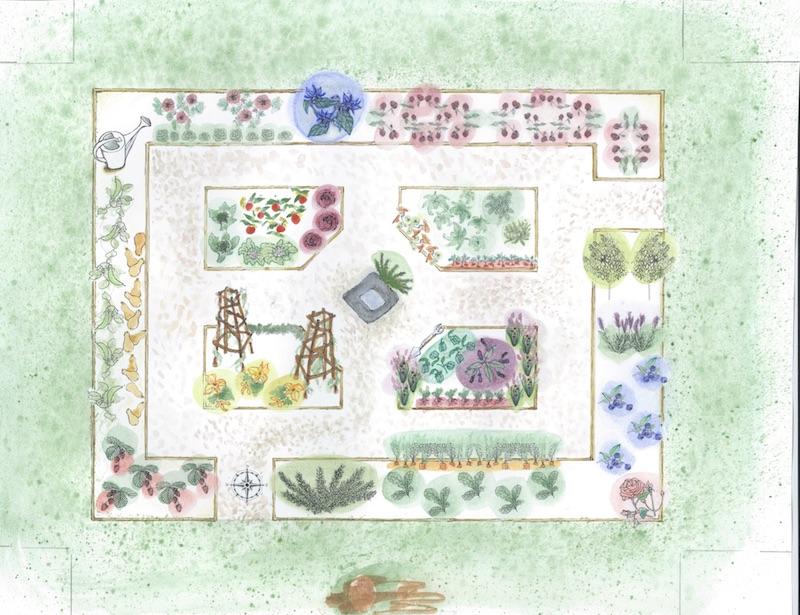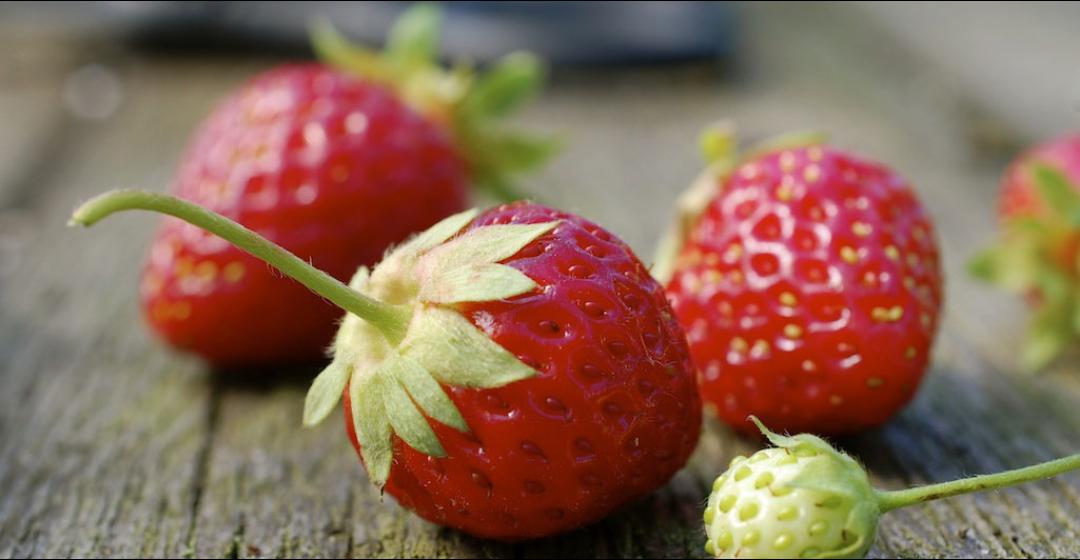What if the secret to happiness lay right outside your kitchen door? In a pretty little garden, full of delicious things to eat. It might sound far-fetched to suggest that a kitchen garden can relieve stress, lift your mood, and even ease depression, but new studies suggest there’s a scientific basis – perhaps even a soil bacterium that elevates serotonin – for the pleasure we can get from digging in the dirt.
I know, I know, there’s a study for everything. If you don’t believe them, just ask your neighbors who’ve already put spade to earth. Katherine Long of West Tisbury says the main reason she has a kitchen garden is for “the joy of walking out early in the morning and breakfasting on my garden – Sungold tomatoes, sweet sugar snap peas, baby kale.” Heidi Feldman of Tisbury says, “I’m a huge believer that getting in touch with the land is literally a de-stresser. What one gains from stepping onto the earth, into nature, is healing and soothing.”
And then there’s the “sheer joy of walking from your kitchen to your garden and back again without needing to drive,” as master vegetable gardener Roxanne Kapitan of Oak Bluffs says. And that’s all before enjoying the incomparable taste and texture of garden-fresh vegetables.
So, um, why don’t we all have kitchen gardens yet? The number one reason people get discouraged is that the “work” overwhelms them. Which is why we’re talking about a kitchen garden here, not a self-sustaining mini-farm with rows and rows of fatigue-inducing weed potential. We need to think small, really small. Forget ambitious. Two hundred square feet is more than enough, and even less will do fine.
“Making a good kitchen garden is like creating a sanctuary,” says Ellen Ecker Ogden, author of The Complete Kitchen Garden (Stewart, Tabori & Chang). “I like to tell people to say they’re going out to ‘play’ in their gardens, not ‘work’ in their gardens.”
Hmmm, if this is sounding like fun to you, have a look at the tips and designs on the following pages to find out how you can create a successful small kitchen garden. Maybe this is your year to find joy digging in the dirt.

Siting It
Stop – put down that seed catalogue. Before you even think about what you’re going to plant, take a stroll outside and find your ideal site. Yes, you need lots of sun and a nearby water source, but if you have to hike way out back or to some other awkward spot to get to it, let’s face it, your garden won’t thrive and you won’t get nearly as much pleasure out of it.
I’ve always loved the idea of having a kitchen garden, well, right outside the kitchen, and when I went to visit my neighbor Katherine Long, I saw firsthand how much pleasure she gets from walking out her back door, across her deck, and right to her garden gate. Even though her gardens – there are two of them actually – are on the west side of the house, the deck is enough of a remove to allow full sun pretty much all day.
Generally speaking, however, the south side of a house is ideal; not only will the building radiate heat but, with a southern exposure, the east-to-west traveling sun will hit the garden all day. Don’t laugh about that east-to-west thing. Garden and landscape designer Mary Wirtz of West Tisbury reminded me that trees can create big shade problems even when they are not located south of a garden. So you may need to be willing to limb, or even lose, those trees if necessary.
That said, a little shade is not a big deal. If you have full morning sun you’re in good shape; if you can stretch that to mid-afternoon, even better. But if you just can’t locate a spot with six to eight hours of sun a day, don’t despair. Even in a mostly shady garden you can grow a lot of leafy greens, such as arugula, mustard, lettuce, kale, and spinach, as well as herbs like parsley, chives, bee balm, and sorrel. It’s the larger fruiting vegetables like tomatoes and bell peppers that need the most sun, and you could always plant a few of those in pots in sunnier spots.
Everyone knows plants need water, but as someone who spends a lot of time lugging hoses around, I cannot overstate that the closer your garden is to a spigot or pump, the better. But you will still need to embrace hoses! Also, if you have the luxury, choose a site that’s somewhat protected from wind, which can be a real issue on the Vineyard. Not only does wind bash plants around, it also dehydrates them (just like us). Little seedlings do not like crusty soil. Also, planting on a slight slope for good drainage is a good idea.
Lastly, soil. Soil science is a subject that makes me kind of anxious now that I am a farmer, but you can keep it simple when thinking about locating your kitchen garden. Of course it is wise to avoid virtual sand traps or clay pits, but chances are that no matter where you locate your garden you are going to have to amend your original soil – any soil – with a lot of organic matter. And in the likely event that you decide to create raised beds, you’ll be filling them with soil and organic composted manure you bring in from somewhere else.
Planning It
Now that you’ve located the garden, you can decide what size and shape it should be. When I polled my gardener friends, they all said smaller is better. In fact, I heard from a lot of people who work full time and have veggie gardens that by keeping the garden small, they are actually able to go to the beach in the summer – what a concept!
“I have strong opinions about this, based on my crazy life and that I do all the work myself,” said Heidi Feldman, of Down Island Farm and Martha’s Vineyard Sea Salt. She has spent years carving out various gardens on her wooded property in Vineyard Haven. “No more than twenty-five feet by twenty-five feet, although my favorite was twelve feet by twelve feet, because then I had time leftover to daydream, too.”
The sentiment was echoed by Chilmark gardener and writer Kay Goldstein, who suggested “no bigger than one hundred to two hundred square feet.” And by home gardener Nicole Cabot, who is the West Tisbury coordinator for Island Grown Schools. “Start small – tiny, even – and have a successful time of it,” she advised.
No matter what size kitchen garden is right for you, a great way to get started on a garden design is use some graph paper and draw out your plan using four feet by four feet raised beds as building blocks. As the three designs shown here illustrate – all of which, by the way, are based on real kitchen gardens here on the Island – by using small raised beds and an optional perimeter bed against the fencing, you can customize a garden that works for almost any site.

Building It
By no means are raised beds a requirement. They are, however, easy to start and easy to work; they’re productive; the soil warms up in them more quickly; and, as Mary Wirtz reminded me, they contain all your good compost and soil so that it is not spilling out onto your paths where you won’t be using it. On the other hand, amending and turning over the soil every year can be a bit more awkward to do in a raised bed than an in-ground bed.
If you go with raised beds, be sure to start with good (untreated) lumber – red cedar is the best choice for longevity. To fill the boxes initially, Wirtz gave me a broad formula. Get a bulk load of compost from Vineyard Gardens or another Island source and fill the boxes about halfway with that. (Bulk compost will usually have some weed seed, so put it in first.) Add a mix of bagged cow manure, worm castings, an organic fertilizer like North Country Organics Pro-Gro (available at SBS and Allen Farm), and quality topsoil to finish filling the box. Line the paths with wood chips or pea gravel, preferably with a weed barrier mat underneath. Hay isn’t a great choice between raised beds, as it tends to mold from the water that gathers there.
If you’re not using framed raised beds, you can line your paths with hay or seaweed, but put cardboard or weed barrier mat down first to really discourage weeds. In this kind of garden, don’t use pea gravel or shells as they will get jumbled up with your soil when you
go to turn over and amend the beds.
I’m afraid fencing on the Vineyard isn’t optional. You don’t necessarily need to have a seven-foot-high deer fence in a small garden that’s close to the house; deer don’t like to jump into small enclosures. But you do need to think about keeping out smaller pests, principally rabbits and dogs. While you can use four-foot green plastic-coated perimeter fencing for the main fence, you should also cover the lower two feet with chicken wire or hardware cloth to deter rabbits. Even better, bury the bottom of hardware cloth in a trench dug six to twelve inches all the way around to discourage rodents. Keep in mind that fencing can sometimes do double-duty as support for peas or vining plants like cucumbers, squash, or nasturtiums. Anything you can train to grow up will save you space in a small garden.
Don’t forget you will need a gate. It doesn’t need to be fancy and you can use your fencing material and scrap lumber to make it. Locating your hose connections along the fence right next to the gate is convenient. I also find that a small potting table or bench right outside the garden gate is a convenient place to leave small tools, gloves, and harvest baskets.
What is all this going to cost you? When I was sitting with Mary Wirtz, she volunteered that for a garden of about 150 square feet of fenced in area, with raised beds, she thought the first year cost of lumber, soil, fertilizer, fencing, and started plants would be between $750 and $1,000. (That is the cost of materials, assuming you would do the labor.) That might seem like a lot of money up front, but if you budget and embrace that now, and build the garden solidly, your kitchen garden will return that investment and much more.
With the infrastructure taken care of, you can have fun “decorating” your kitchen garden with whimsical and repurposed or salvaged garden art – old watering cans, glass bottles, wrought-iron plant stands, stones, bricks, hooks. Ellen Ecker Ogden always recommends having a bench inside the garden, so you can sit and enjoy it anytime. I love that idea, and even if you don’t have room for a full-sized bench, you can scatter little mini-benches or step-stools for people to perch on.

Planting It
Finally, it’s time to decide what to plant. Of course, this is where you get to be creative and have fun, so you could basically ignore my advice. But I thought you might like to see what some seasoned gardeners said when asked what their top ten picks would be for a kitchen garden. I compiled the list (and yes, fiddled with it a bit), but before you look at it, consider a few helpful rules for prioritizing when space is limited:
First, choose mostly veggies and herbs that yield continuously for several weeks. I’m talking about the “cut-and-come-again” crowd (like most salad and cooking greens), or the “pick and pick again” veggies (like green beans), as opposed to a carrot or a beet that once dug leaves nothing but a hole. Also, for early gratification, look for plant varieties like arugula that begin yielding early, after only a few weeks, or something like baby bok choy that matures in about six weeks.
Second, make room for things like fresh basil that are hard to get in good condition at the grocery store, or herbs like thyme or cilantro that you use often but only in small amounts, making the bigger bunches in the grocery store rather wasteful. You might throw in something like a tomatillo or a special chili pepper that would be impossible to find at the grocery.
Third, consider the space the plant takes up compared to what it yields. A butternut squash vine can meander for ten feet and only yield a few fruits after three months in the ground, while you could pick a serving of green beans every day from a few (bush) bean plants during that same three months.
Consider what you can get at farm stands and farmer’s markets. We all want to grow things – like tomatoes – that have a taste and texture straight from the garden that is nearly impossible to come close to with a grocery store purchase. But many (maybe most) vegetables will fall into this category, so prioritizing your choices based on taste and texture can be difficult. If you really love something, think about whether you can get it, in season, from one of our Island farms. If not – and you’re in love with it – then plant some of it for Pete’s sake!
Dial in the kid factor. We have a strange child who actually seems to like arugula and Brussels sprouts as much as Sungold tomatoes. But if you’ve got young kids, be sure to plant something delicious like sugar snap peas for them. You might also want to leave a couple square feet of dirt open for them to play or plant in. (Our child created a plant hospital in her space!)
Even in the smallest, newest kitchen garden, plant a perennial or two, like a rhubarb plant or winter-hardy herbs like thyme and sage. We’re thinking positive here – we know you’ll be hanging around for year two, and nothing’s more fun than seeing a perennial vegetable or herb show up or green up in the spring. Plant a blueberry bush next to the garden gate.
Remember you don’t need to (or want to) start everything from seed. Take advantage of the high-quality seedlings we have available at Island nurseries and buy your “starts” there. You will get happy, healthy plants without having the heartache of weak seedlings, the expense of grow lights, and the extra time you’d have to wait to harvest if you direct sowed veggie seeds. The exceptions are peas (direct sow in early spring) and quick-to-germinate greens like arugula, kale, and mustard, which you’ll likely want to sow more than once. (Use them to fill those holes after harvesting carrots – you can sow all summer long!) Lettuce is easy to direct sow too, but six-packs of healthy lettuce seedlings are a real treat, since you can plunk them in the ground and be harvesting in no time.
The Top 10 Garden Plants – A Biased List
1. Salad Greens
• A mix of lettuces. Choose at least one bibb/butterhead, a few red and green looseleaf lettuces like Salad Bowl and Red Sails, a pretty romaine like Freckles, and a ringer like Speckled Amish.
• Asian greens. Mizuna and mustards (Osaka Purple, Ruby Streaks) are easy to grow. Direct sow seeds and pick leaves at baby stage.
• Arugula. Cut frequently until flower stems appear. Reserve space to plant new patches of arugula throughout the season.
- 2. Kale
Go for more than one variety (I like Red Russian and Purple Lacinato). Sow thickly to harvest as baby greens. Buy a piece of floating row cover and some fabric pins to protect from cabbage butterfly/worms. Collards are a great alternative. If you’re not into Brassicas, plant another work-horse green like Swiss chard.
- 3. Tomatoes/ Cherry Tomatoes
Three or four tomato plants is all you really need in a kitchen garden. Include at least one cherry tomato. Sungold is the hands-down favorite for sweet flavor, Sweet 100 is deeply tomato-y flavored and a bit more prolific.
- 4. Cucumbers or Pickling Cucumbers
Train vines up a trellis or fence to save space. Water profusely and consistently.
- 5. Basil
On every cook’s list, fragrant garden basil likes plenty of water, morning sun and a bit of afternoon shade, mulch, and even a floating row cover to protect from beetles. Plant sweet basil and one other variety, like lime basil or Thai basil.
- 6. Parsley – Italian (Flat-Leaf) or Curly
Once planted in spring, a few parsley plants will yield beautiful lush foliage from summer through winter. It will flower and go to seed the following spring. Always buy started plants, as germinating parsley is painfully slow.
- 7. Sugar Snap Peas/Shelling Peas
Both sugar snap peas and English shelling peas are garden treats not to be missed. Direct sow seeds since plants don’t like transplanting. Sugar snaps often don’t need support; shell peas need a trellis. Protect newly planted seeds and emerging seedlings from birds with floating row cover.
- 8. Green Beans
Bush beans (green, yellow, or purple) are super easy to grow with few pests. Pole beans have deeper flavor but yield less and later and need support. One trick: plant pole beans when peas are done in July, using pea trellis for support.
- 9. Zucchini/ Summer Squash
Summer squash are space hogs, but finding the little treasures under those big leaves every day is a kick. And you’ll never be without a vegetable for dinner. Picked young and small, the flesh is firm and sweet. My favorite variety is Sunburst pattypan.
- 10. Hardy Herbs
Thyme, sage, and oregano will make it through the winter on the Island. Depending on your microclimate, rosemary might, though you can always pot it up and take it inside to a sunny, well-ventilated spot for the winter. I wouldn’t have a kitchen garden without rosemary; I love it that much. Perennial chives are so cheery and useful (and impossible to kill). Love those purple flowers. Also try flat-leaved garlic chives (beautiful white flowers in fall).
Bonus Candidates:
Other fresh herbs like cilantro, dill, tarragon, and chervil are popular with kitchen gardeners and don’t take up much space. Cilantro grows easily (and best) from seed, and self-seeds promiscuously. Don’t worry when it “goes to seed” and starts flowering around the June solstice. The flowers are beautiful and delicious in salads and the coriander seeds that follow are harvestable too. Dill and fennel also go from leafy to flowery pretty quickly, but I’ve learned to love this.
You should absolutely have a few flowers in your kitchen garden. A nice option is edible flowers that also attract bees and other beneficial insects, like borage, anise hyssop, dill, and sunflowers. Nasturtiums, with their beautiful and edible leaves and blossoms, are my hands-down favorite kitchen garden flower. The colorful plants really come into their own in September and October.
Two other high-producing vegetables should be on the list: hot peppers and small eggplants. You can tuck one or two jalapeno or serrano plants or a Fairy Tale eggplant into your kitchen garden while barely disturbing the footprint.
Last, consider rhubarb (plant it with lots of composted manure) in one corner of the garden, and if you’ve decided on one of the bigger designs and have a border bed to spare, go ahead and plant asparagus (again, with plenty of composted manure). The foliage gets quite tall so be sure it won’t be shading other sun-loving veggies. I’ve always wished I had planted asparagus sooner since it takes a few years to mature.
Strawberries? They’re a conundrum. Having only one or two plants will frustrate you; more will spread everywhere. I say don’t worry about the spreading and go for it! Tuck some in somewhere, because warm, juicy garden strawberries are pretty
much the definition of joy, as far as I’m concerned. One definition, anyway.





